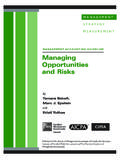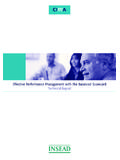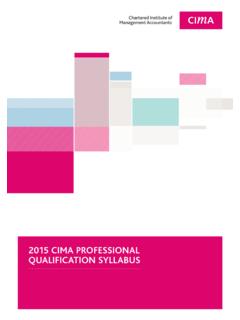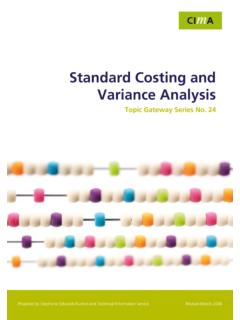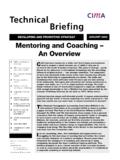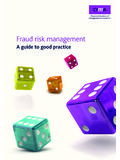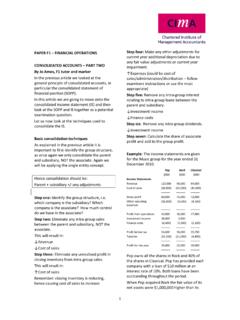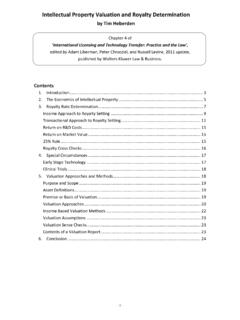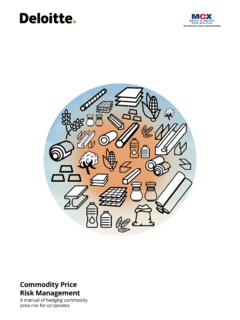Transcription of Understanding corporate value: managing and reporting ...
1 Understanding corporate value: managing and reporting intellectual capital31 Introduction42 Definitions of intellectual of intellectual is intellectual capital so difficult to measure?3IC measurement 8 Generic assets map approachIndividual company Skandia s cockpit s intangible assets s holistic company Gruppen CompanyIQ measurement systemIC value-added value creation or value-based s intangible assets to earnings the Baruch Lev resource intellectual capital coefficient4 Knowledge process management and the accounting profession5 reporting intellectual and financial capital reports6 Conclusion26 Writers.
2 Danka Starovic, project manager, technical issues, CIMA, and Bernard Marr, research fellow in the Centre for Business Performance at Cranfield School of ManagementProduction editor: Sarah Vaux Designer: Adrian TaylorPublisher: Chartered Institute of Management Accountants Inquiries: (tel: 020 8849 2275) intellectual capital ContentsKnowledge being the new engine ofcorporate development has become oneof the great clich s of recent years, butthere is no doubt that successfulcompanies tend to be those thatcontinually innovate, relying on newtechnologies and the skills andknowledge of their employees ratherthan assets such as plants or machinery.
3 Value can be generated by intangiblesnot always reflected in financialstatements and forward-lookingcompanies have realised that these arean integral part of fully understandingthe performance of their business. At the height of the dotcom boom,companies with almost no assets in thetraditional sense of the word werehaving their stocks more highly ratedthan many of the stalwarts of Britishand global industry. Much of thediscussion about intangibles thus grewout of early attempts to account for thesometimes staggering differencebetween the so-called book and marketvalues of then we have had the UScompany collapses, followed by a bearmarket that continues to shrink thevalue of equities around the still matter.
4 But the keydriver for measuring and reportingthem has become understandably wary about the possibility of inflated earnings after Enron or WorldCom areputting pressure on companies to reportall the value drivers of theirperformance and that unavoidablyincludes non-financial it is not only investor pressure thatis forcing companies to accept thatmanaging intangibles is no longer anoptional extra. Forthcoming legislationon issues such as the operating andfinancial review, due to be included inthe Companies Act 2003, requires largepublic and very large private companiesto provide a qualitative as well asfinancial evaluation of performance,trends and intentions.
5 In other words,companies will have to produce anaccount of how their intangible assetscontribute to overall value generation. This briefing is an attempt to raiseawareness of the need for companies ofall sizes to manage and communicatethe value of their business beyond thatcaptured by numbers alone. Somecompanies, usually large, have alreadyimplemented various intellectual capital (IC) measurement tools and rest see themselves as being toobusy simply surviving to worry aboutwhat seems like an unnecessary included is a summary of someof the current approaches and modelsused for valuation and measurement.
6 Allhave limitations and many suffer from alack of practical testing. But this is still adeveloping field, with contributions frommany disciplines, so the lack ofconsensus is not surprising. Moreexperimentation and convergence interminology and tools will eventually benecessary if the concept of intellectualcapital is to become widely acceptedand put into is not an attempt to criticise ordevalue the traditional model offinancial reporting . Some intangibles are already included on balance sheets;others are not, for a reason. Traditionalreporting has served its purpose well, but now forms only a part of the jigsaw of how value is created and communicated.
7 intellectual capital andaccountants in businessIn a recent KPMG survey of non-executive directors (Neds), more than 60 per cent of the sample said theydidn t consider themselves to be veryknowledgeable about non-financialperformance indicators. In fact, it camelast on the list of suggested topics. Notsurprisingly, financial performance wasat the top, with 94 per cent saying thiswas an area where they were mostknowledgeable. As many Neds aresenior managers or executiveselsewhere, it is safe to assume this isfairly is not simply that directors are notup to speed on intangibles , althoughsome of them may well not know muchabout the subject.
8 The main reason citedfor this worrying shortfall is that information provided by executives ismainly financial . Comments like thisclearly spell out the challenge ahead foraccountants. As the main custodians ofperformance data in companies, theyneed to ensure that the rightinformation is communicated to the1 Introduction4 intellectual capital 5right people. Effective strategic andoperational decision-making hinges onthat information being relevant, timelyand robust and that means it has toconsist of more than just briefing is therefore primarilyaimed at finance professionals andaccountants in business who would liketo implement or improve themeasurement and management ofintellectual capital in their ownorganisations.
9 It will also be useful toanyone looking for a generalintroduction and an overview of the keyconcepts of intellectual capital andknowledge should you manageintellectual capital ?Traditionally, the only intangible assetsrecognised in financial reportingstatements were intellectual property,such as patents and trademarks, andacquired items such as it is still not possible to assignmonetary values to most internallygenerated intangible assets, theynevertheless need to be considered ifthe process of value creation is to beproperly to do so can have damagingconsequences at all levels.
10 For anindividual firm, not Understanding howvalue is generated can lead to inefficientresource allocation. It means thecompany does not fully understand itsbusiness model and may therefore beunable to assess the value of futurebusiness opportunities. On a wider scale,it can lead to anomalous marketbehaviour: if the markets don t get theinformation they need through official channels they may resort to rumoursand speculation, which could lead tovolatility. There may also be amisallocation of resources on a macrolevel in terms of market investments. Some go as far as to say that the lackof Understanding of intellectual capitalby market participants contributed tosome of the spectacular market failuresin the past few years (Holland, 2002).
